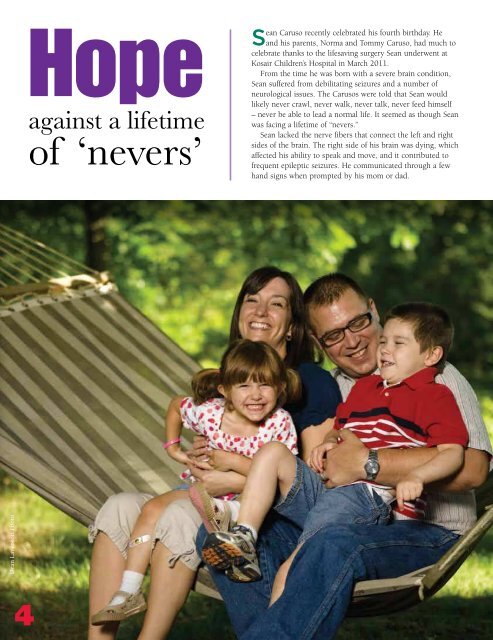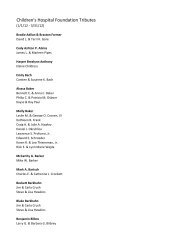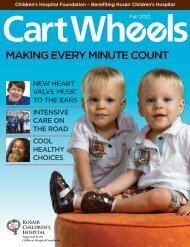Fall 2011 - Kosair Children's Hospital
Fall 2011 - Kosair Children's Hospital
Fall 2011 - Kosair Children's Hospital
Create successful ePaper yourself
Turn your PDF publications into a flip-book with our unique Google optimized e-Paper software.
Dean Lavenson Photo<br />
Hope<br />
against a lifetime<br />
of ‘nevers’<br />
Sean Caruso recently celebrated his fourth birthday. He<br />
and his parents, Norma and Tommy Caruso, had much to<br />
celebrate thanks to the lifesaving surgery Sean underwent at<br />
<strong>Kosair</strong> Children’s <strong>Hospital</strong> in March <strong>2011</strong>.<br />
From the time he was born with a severe brain condition,<br />
Sean suffered from debilitating seizures and a number of<br />
neurological issues. The Carusos were told that Sean would<br />
likely never crawl, never walk, never talk, never feed himself<br />
– never be able to lead a normal life. It seemed as though Sean<br />
was facing a lifetime of “nevers.”<br />
Sean lacked the nerve fibers that connect the left and right<br />
sides of the brain. The right side of his brain was dying, which<br />
affected his ability to speak and move, and it contributed to<br />
frequent epileptic seizures. He communicated through a few<br />
hand signs when prompted by his mom or dad.<br />
Six months after hearing the long list of nevers and many<br />
therapy sessions later, Sean met with the neurology team at<br />
<strong>Kosair</strong> Children’s <strong>Hospital</strong>.<br />
Initially, Sean’s seizures were treated with medication. But<br />
the combination and large dosages created additional issues.<br />
His seizures continued to grow stronger and occur more<br />
frequently. Every time he would experience a seizure, he<br />
would lose much of what he had learned since the last one.<br />
“It was a never-ending, vicious cycle,” Norma said. “We<br />
knew his little body couldn’t keep it up forever.”<br />
According to Vinay Puri, M.D., director of child neurology<br />
for <strong>Kosair</strong> Children’s <strong>Hospital</strong> and the University of Louisville<br />
School of Medicine, surgery was the only option in order for<br />
Sean to have a meaningful quality of life.<br />
“Given the level at which Sean’s seizures were progressing,<br />
performing surgery was the only<br />
treatment that would allow us to stop<br />
him from seizing and give him a chance<br />
at life,” Dr. Puri said.<br />
Sean was scheduled for a<br />
hemispherectomy, a rare surgical<br />
procedure in which one-half of the<br />
brain is removed or disabled. Less than<br />
200 hemispherectomies are performed<br />
each year worldwide.<br />
“When the procedure was first<br />
explained to us, we were a bit<br />
unnerved. It’s hard to imagine having<br />
half of your brain removed and still<br />
being able to function,” Tommy<br />
said. “Sean’s doctors explained that<br />
sometimes removing part of an organ<br />
that has been severely damaged is better<br />
than having a damaged organ.”<br />
This particular epilepsy surgery is<br />
especially effective in children under<br />
age 6, because the part of the brain<br />
that remains can compensate for what<br />
is missing, according to William C.<br />
Gump, M.D., pediatric neurosurgeon,<br />
Norton Neuroscience Institute.<br />
Sean’s surgery marked the first<br />
hemispherectomy performed at<br />
<strong>Kosair</strong> Children’s <strong>Hospital</strong>.<br />
“Up until this point, eligible patients<br />
for this procedure had to travel far<br />
distances for treatment,” said Shefali<br />
Karkare, M.D., pediatric epileptologist<br />
and director of the pediatric epilepsy<br />
surgery program at <strong>Kosair</strong> Children’s.<br />
The six-hour procedure involved<br />
removing the right side of Sean’s brain<br />
and implanting a shunt to drain fluid.<br />
Sean Caruso of Crestwood, Ky., with parents<br />
Norma and Tommy Caruso and sister C.J.<br />
“We could tell a difference almost immediately,” Tommy said.<br />
“One of the first things Sean signed after the surgery was the<br />
sign for ‘boo-boo,’ pointing to the boo-boo on his head.”<br />
Before the surgery, Sean’s parents would have had to coax him<br />
to communicate.<br />
Sean’s road to recovery involves ongoing speech and physical<br />
therapy. According to Tommy, they have been given a clean slate.<br />
Today, Sean engages in conversations and is able to<br />
communicate with his family through sign language and some<br />
verbal sounds. Sean has not had any seizures since his surgery.<br />
We used to hold our breath when we<br />
would go to wake Sean up in the morning,<br />
not knowing what to expect. Now we go<br />
in with a smile excited to start the day<br />
with our miracle boy.”<br />
–Norma Caruso<br />
His vocabulary has increased, and he’s walking and talking more<br />
every day.<br />
“We used to hold our breath when we would go to wake Sean<br />
up in the morning, not knowing what to expect,” Norma said.<br />
“Now we go in with a smile excited to start the day with our<br />
miracle boy.”<br />
“People ask me how it feels knowing we saved Sean. I tell<br />
them he’s the one who saved us,” Tommy said. “He is a kind,<br />
sweet little boy, and a great example of courage and quiet<br />
strength. Every day, he reminds me of the kind of person I need<br />
to be.”<br />
–Michelle Robey<br />
<strong>Kosair</strong> Children’s <strong>Hospital</strong> expands<br />
pediatric epilepsy treatment options<br />
The department of child neurology at <strong>Kosair</strong> Children’s<br />
<strong>Hospital</strong> and the University of Louisville School of Medicine<br />
recently expanded epilepsy treatment capabilities to improve<br />
outcomes for families and children living with epilepsy.<br />
A larger team of pediatric neurologists, epileptologists,<br />
neuropsychologists, neurosurgeons, epileptic nurse practitioners<br />
and additional state-of-the-art monitoring technology and<br />
surgical capabilities give families like the Carusos access to the<br />
best medical care possible without having to leave their home<br />
and support system.<br />
A new epilepsy monitoring unit, funded by the Children’s<br />
<strong>Hospital</strong> Foundation, is equipped with continuous video<br />
electroencephalogram monitoring. This and other new testing<br />
help doctors understand exactly where seizures start in the brain.<br />
For more information about the epilepsy program at<br />
<strong>Kosair</strong> Children’s, visit <strong>Kosair</strong>Childrens.com. Would you<br />
like to help support initiatives such as this? Call the Children’s<br />
<strong>Hospital</strong> Foundation at (502) 629-8060.<br />
4 5




